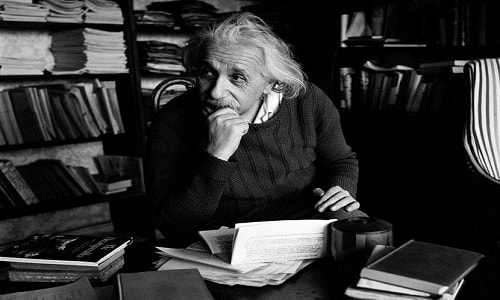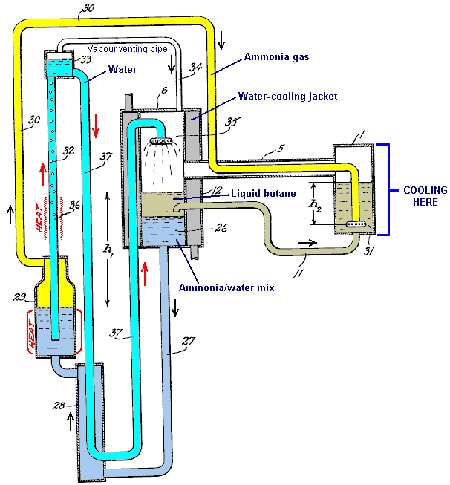Einstein's Fire-Freezing Water Machine
Einstein and Szilard's refrigerators were non-toxic and did not leak ozone-depleting gases, but were too complex for households.
 |
Einstein spent time researching refrigerators that did not leak toxic gases. Photo: YouTube. |
One morning in 1926, scientist Albert Einstein read shocking news in the newspaper about a family in Berlin, Germany, including children, suffocated to death when the refrigerator's seal broke and poisonous gas spread throughout the house. He immediately contacted his friend Leo Szilard, a young scientist and inventor, to find a way to improve the refrigerator.
At that time,Refrigerators that use low-boiling liquids to lower temperatures are commonly used in homes in Europe and North America. These refrigeratorsThere are several pipes containing a low boiling point liquid. This liquid absorbs the heat emitted from the food through the refrigerator walls and heats up to boiling point, turning into a gas that escapes through other pipes, carrying the heat with it.
This gas then enters the compression chamber, where it is condensed by a piston. The compressor motor, which makes the characteristic noise of a refrigerator, pushes the hot gas through many pipes at the back of the refrigerator, radiating heat away. The hot gas gradually loses all its heat, condenses into a liquid, flows through a pressure reducing device and cools, starting a new cycle of heat absorption.
The three gases commonly used as refrigerants at the time were ammonia, methyl chloride, and sulfur dioxide, all of which were toxic. This was the reason Einstein was determined to find a better solution for making refrigerators.
Einstein knew that the weakness of domestic refrigerators was the compressor, because their seals often burst under pressure. So he and Szilard built a refrigerator that did not need a compressor, called a vacuum refrigerator.
In a simple vacuum refrigerator, two liquids, the absorbent and the refrigerant, are mixed together in a chamber. At low temperatures, the two fluids mix, but if the temperature is increased, usually by heating the chamber with a small methane flame, the refrigerant boils and vaporizes into a gas, separating from the absorbent.
The refrigerant flows through the tubes and gives up heat, returning to liquid form. It then flows into channels inside the refrigerator and absorbs heat from the food again, boiling and turning into a gas.
Meanwhile, the methane fire in the original chamber would be extinguished to allow the absorber to cool. It would be further cooled by cold water, then become so cold that when the refrigerant returned to the chamber, the absorber condensed it back into liquid form and reabsorbed it. With the mixture of two liquids that could be separated by fire, the cycle began anew. “The Fire-Freezing Water Machine” was a rather apt name for Einstein and Szilard’s invention.
 |
The cooling mechanism in an Einstein-Szilard refrigerator. Graphics: EDN. |
The Einstein-Szilard refrigerator actually uses three types of liquid and gas, making the process a little more complicated. However, their invention has several advantages over conventional refrigerators. Because it doesn’t use a motor, it’s quiet and rarely breaks down, it doesn’t use electricity, and it doesn’t require seals that can break and leak toxic gases.
Einstein and Szilard received patents in six countries for various components of the refrigerator. They sold some of the patents and earned $750 (about $10,000 today). They also developed two new refrigerator designs, one using molten sodium, the other using water pressure from a kitchen faucet.
The fate of the new refrigerator
However, none of Einstein's and Szilard's three refrigerators ultimately found widespread use in homes. The sodium-smelting type was impractical for the average kitchen. The water-pressure type failed because German apartments had poor water pressure. The suction refrigerator burned too much fuel compared to compressor-powered refrigerators.
Meanwhile, the problem of toxic gases in traditional refrigerators was solved in 1930, when scientists discovered a new, non-toxic refrigerant gas called Freon (chlorofluorocarbon). Within a decade, every family had switched to this new type of refrigerator, making the inventions of Einstein and Szilard a thing of the past.
But Freon has a major drawback. When it leaks and escapes into the stratosphere, ultraviolet light splits chlorine atoms, creating free radicals that damage ozone molecules. Each chlorine free radical can destroy 100,000 ozone molecules, causingThe hole in the ozone layer is still there today and will not be repaired for several decades. If humanity had invested in the Einstein-Szilard flame cooling method earlier, it would have saved us a lot of long-term problems with the ozone layer.
However, Einstein and Szilard's invention of the refrigerator was not a complete waste. It gave Einstein a break and a decent amount of money. Szilard also earned enough money to continue his research. He later discovered the principle behind the first nuclear chain reaction.
According to VNE
| RELATED NEWS |
|---|
